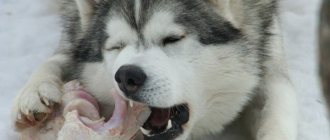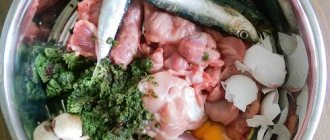How to feed a puppy correctly?
Do you want to know what you can and what is the best way to treat your little furry so that he turns into a beautiful and healthy dog? Then we will try to delve deeper into this difficult issue. Experienced dog breeders do not consider this topic particularly problematic and feed the puppy “automatically,” so to speak. But someone who got a dog for the first time has a million questions about nutrition at the same time, and everything needs to be answered immediately, since a living creature will not wait.
It is very important not to overfeed the puppy, breaking his stomach to incredible sizes. Regular overeating has just as bad an effect on the animal's condition as undernutrition. Large breed dogs that quickly gain weight have a good chance of developing joint problems.
Next, you will learn what to feed your puppy, how to choose the right combination of foods for the menu, and also what foods should be kept away from the dog.
How to properly feed a puppy natural food?
The first thing a dog owner should understand is that his food should always be fresh. After all, for ourselves, don’t we buy meat a little cheaper and tastier? You should treat an animal with the same responsibility as you would treat your child. Poisoning from poor-quality food is a common occurrence in pets.
A dog at home is often fed natural products. It will cost a little less than dry food, and the owner can always be sure of the quality. But you should immediately prepare for the fact that now you will be faced with frequent and regular purchases, heavy bags and constant cooking, because at first the puppy eats very often. If this doesn’t scare you, let’s take a look at the list of products that the growing body of a dog of any breed requires.
Important!
Never give your puppy food from your table - such food is absolutely not suitable for him, even if it is aromatic borscht cooked with soul.
So, to feed a young dog we will need:
- Milk. A small puppy is fed milk for up to 4 months. It is vital for the pet for normal growth and development. Milk is given in its pure form or porridge is cooked with it. But here the question arises - what kind of milk should I feed? It is better if it is goat, since allergies to it are very rare. But it is not always possible to get it. Therefore, cow's milk is suitable, but not whole, but diluted, so as not to cause upset in the puppy. Closer to 6 months, the amount of milk is reduced, and then it is removed altogether, replacing it with sour milk.
- Dairy products. For good digestion, as well as to enrich the body with calcium, a young dog must be given cottage cheese, kefir, and low-fat sour cream. Not everyone knows that you can give your puppy a serum that contains a lot of useful substances, but it costs literally pennies. When the puppy grows up, the amount of fermented milk products will be much less - 2-3 times a week. Hard cheese is very useful for a puppy, which is given to him as a reward for success in training.
- Meat. It should be at least 40% in the diet or 20-30 grams per kilogram of weight. Meat is given raw, frozen, boiled or scalded. However, most of the time the puppy is fed raw meat, since the dog is, after all, a predator. It is allowed to feed the puppy skinless chicken, turkey, veal, beef, and horse meat. In addition to pure meat, meat by-products are very useful for a puppy. Like meat, they are given cooked or raw. It is very good to include a cow's stomach, udder, trachea, liver, and kidneys in the diet of a growing dog. All meat products should be cut into small cubes, but not in the form of minced meat.
- Fish. The puppy should be given fish or seafood twice a week. It can be squid, shrimp, mackerel, hake, pollock. If you are confident in the purity of the product, then boiling is not necessary. But it is better to refuse river fish. In addition to the high risk of infection with helminths, there is a chance that the puppy will choke on a bone, since they are very small and it is simply unrealistic to choose everything. Fish is given instead of meat feeding.
- Vegetables. Every baby needs vitamins. Most of them are found, of course, in vegetables. Gradually they are offered to the animal, mixed with cottage cheese or porridge. You can grate them on a fine grater and serve them fresh or stewed - this way they are better absorbed without causing upset. It is good to give the puppy pumpkin, carrots, zucchini, beets, and also add a little greens - onions, parsley, spinach.
- Berries and fruits. Many dogs love fruit. But not all owners know whether they can be allowed to eat them. You definitely can’t force a dog to eat something that is healthy if it doesn’t want to. But if your dog happily crunches an apple or picks up fallen apricots and at the same time everything is fine with his digestion, this vitamin supplement is very useful. It is undesirable to give your puppy grapes and currants, which cause bloating and accumulation of harmful substances in the body. You need to be careful with stone fruits, which contain hydrocyanic acid, as well as with bananas - they quickly make the puppy fat.
- Cereals. It is mandatory to feed the puppy porridge. But it serves only as an addition to the main milk and meat diet. Under no circumstances should your puppy eat only cereal. In the first months, baby porridge is cooked in milk. It could be semolina, rice, buckwheat, oatmeal. You need to watch how the dog tolerates this or that product. If buckwheat doesn’t work out and the dog gets upset from it, then this grain is excluded for a while.
Important! As an invaluable protein product, you can and should use egg yolks both in their pure form and in the form of an omelette twice a week, but it is better to give quail eggs.
How to properly feed a puppy dry food?
Feeding a growing dog natural food is cheaper, but the preparation process takes a lot of time. It is much easier to give your baby dry puppy food. It is properly balanced and there is no need for additional vitamins and minerals.
There are three classes of food:
- Economy;
- Premium;
- Super premium.
The last two are recommended for dogs whose owners really care about their health. Let's find out which brands of puppy food are the healthiest and most popular:
- Hill's
- Royal Canin
- Eagle Pack
- Purina Proplan
- Genesis
- Diamond
Important! If you don’t know what is best to feed your puppy, and you decide to switch your baby from natural food to dry food, then you need to do this gradually. The same applies to changing the brand of food.
Please note that it is better to give dry food to a puppy in a soaked form. To do this, half an hour before feeding, the crackers are poured with warm water to swell. You should never use broths for this - only clean water. The food packaging indicates the norms for each age. These should not be exceeded due to the risk of nutrient overdose. Owners should be aware that dry food is given less than natural food due to its high concentration and calorie content.
Important! For those who give their puppy dry food, there is good news - the number of bowel movements per day will be less than with natural food. So you will have to clean up less too.
Genetic characteristics of the health of mongrels
Every potential owner who decides to get a mongrel dog agrees to a kind of “lottery”. The main advantage is the genetic characteristics of the health of mongrels, but this does not mean that outbred dogs do not get sick or can get by with poor quality nutrition. Potentially, mongrel dogs are healthier, smarter and more comfortable because they instinctively adapt to their owner's needs.
The diet for a dog should be compiled as individually as possible, since outbred dogs can inherit the not very “successful” genes of some ancestors.
The statements below are myths and are spread by illiterate people:
- Mongrels are omnivores - no, for a mongrel dog you need to select the appropriate diet.
- Mutts can be fed table scraps - absolutely not, since the dog's genetic inclinations are unknown.
- Mutts do not need to be bathed - they do, but not often. They also need to be combed, and wire-haired dogs need to be trimmed.
- Mutts have strong immunity and do not need to be vaccinated - the immunity of mongrel dogs is indeed stronger than that of mongrel dogs, but it is not a competitor to deadly viruses.
- Worms and fleas in a mongrel can be treated with folk remedies - it is possible, but is it necessary? Folk remedies can be toxic not only to parasites, but also to the pet. Questionable savings can lead to tragic losses.
Statistics reveal a number of facts about the health of mongrel dogs:
- Short-haired mongrels are more likely to suffer from plant protein allergies.
- Long-haired dogs are prone to skin problems.
- Mutts age later, but develop earlier.
- In old age, mongrel dogs are less likely to have dental problems.
- At the age of 3 years and older, mongrel dogs are prone to gaining excess weight.
When preparing a diet for a mongrel dog, you need to take into account its past. It is important not only to choose a high-quality diet, but also to correctly calculate the daily food intake. Practice shows that dogs that were once hungry are prone to overeating, even when they are pets and not deprived of anything.
How many times a day should you feed your puppy?
Babies need as many meals as their age dictates. The smaller the puppy, the more often it needs to be fed. At about one month of age, puppies are allowed to feed on their own, gradually transferring them from milk feeding to regular food.
Look at the approximate feeding plan for the day;
- up to two months – 5-6 times;
- from two to four – 4-5 times;
- from four to six – 3-4 times;
- from six to ten – 3 times;
- from ten to one year - 2 times.
Keep in mind that at night, namely from 22.00 to 6.00, the puppy should have a break. There is no need to feed him even if the baby whines at night. Firstly, this is a bad habit that will stick for life, and secondly, the stomach needs rest, that is, time when it is free from food. To prevent the puppy from being hungry, he is fed milk porridge or meat at night.
Important! If for some reason you missed feeding, you cannot give double the norm next time. Feed your puppy the same as usual to avoid overfeeding.
Large breeds
Features of the norms for feeding a puppy of a shepherd dog, labrador, husky, alabai, husky and other large breed dogs include an increased amount of protein compounds. In this case, lean meats should be combined with boiled or stewed vegetables. This food is best given to the puppy before bedtime and only in small portions.
With a properly formulated diet, a large breed pet should gain approximately 150 grams of weight every day. It is allowed to use both ready-made industrial feed and natural food. Ready-made food should be intended for puppies of large breed dogs. To understand how much food to give an animal at a time, you should divide the amount indicated on the package per day by the number of feedings.
You should know that large breeds are predisposed to joint diseases, so you should not overfeed the animal at an early age.
How to feed one-week-old puppies without a bitch?
Unfortunately, there are situations when the owner has to take on the role of the puppies’ mother, feeding them artificially. Feeding newborn puppies is not easy - you will have to devote all your time to this. Don't know how often you'll have to feed your babies? This will have to be done every two hours.
There are several options for feeding a puppy/puppies left without mother's milk:
- The easiest way to purchase is the so-called “bitch milk”, which is sold in powder form in packages of different capacities. The selected ingredients are as close as possible to the composition of the bitch's milk.
- The second option is to make your own formula for feeding puppies if you have cow's or goat's milk. To do this, take 3 yolks, a pinch of salt, a quarter teaspoon of vitamins (liquid) and a spoonful of corn oil per liter of milk. This mixture is brought to 35°C and fed to the puppies using a bottle with a pacifier. Babies are fed this way for up to three weeks, after which crushed regular food is gradually introduced.
Basic Rules
Regardless of your pet’s nutrition plan and feeding schedule, you should follow some rules:
- The feeding portion of any puppy should contain the amount of food according to the size of the baby.
- The portion increases according to age.
- The menu must include fermented milk and vegetable dishes.
- It is not recommended to feed babies dry food until they are three months old. If you need dry food, you should buy food specifically for dogs from one month old.
- A bowl of food should be given for no more than 15 minutes. This will help teach the animal discipline. There is no need to remove the cup of water.
- For the same reason, feeding should be done at a strictly defined time.
- When introducing a new product, it is given in small portions.
- After the baby has eaten, he needs to be given a little time to rest, after which he can begin active games.
- It is forbidden to alternate natural and dry food.
- The schedule should include fasting days a couple of times a month.
- Gradually, you can introduce various additives into the menu: chalk, fish oil.
A puppy's feeding regimen directly affects its health, no less than heredity. In this regard, it is important to select food in accordance with the individual and age characteristics of the pet.
What to feed a one-month-old puppy?
You're probably wondering at what age can you buy a puppy? There is no consensus on this matter. Some people think that it’s better early, while others believe that no earlier than 2-3 months after the end of the vaccination quarantine. Professional breeders can start selling puppies after activation, that is, at 45 days.
However, if the puppy is sold without a document, then you can buy it earlier. The owners begin to sell young animals at the age of one month. At the same time, some of them already feed babies from three weeks so that they themselves can eat from a bowl. When you bring the puppy into the house, you should prepare the necessary minimum of food for two to three days.
This list includes:
- rice/buckwheat/oatmeal;
- beef/chicken;
- beef tripe or other offal;
- pumpkin/carrot;
- cottage cheese and kefir;
- milk and semolina.
During the month, babies need to be fed every three hours, each time offering different dishes. Eg:
- 6.00 – semolina porridge;
- 9.00 – oatmeal with carrots and meat;
- 12.00 – cottage cheese with kefir;
- 15.00 – rice porridge with vegetables and offal;
- 18.00 – rice/buckwheat with meat and vegetables;
- 21.00 – semolina porridge.
Please note that all foods in the diet should be crushed as much as possible, but not in a blender, as the dog needs to learn to chew food. At first, the meat is given boiled, but after a week it can already be given raw in two out of three feedings. Food should be at room temperature or slightly warmer, but not cold or hot.
Important! The amount of food per day for a one-month-old puppy is calculated based on the breed - the larger the dog, the more food it needs.
Vitamins and supplements
If the puppy is alert, his skin and coat are clean and shiny, and his feces are constantly formed, then there is no need for additional vitamin preparations.
Vitamins are a medicine that is prescribed for vitamin deficiencies. If the diet is varied and balanced, the vitamin composition will be complete.
If clinical signs of disease appear, you must contact a specialist, and he will prescribe the vitamins that he deems necessary based on the results of the examinations.
Self-prescription of seemingly harmless drugs is fraught with an overabundance of substances and can lead to irreversible consequences.
What to feed a two month old puppy?
The dog at two months is strikingly different from what it was a month ago. And all thanks to the fact that he receives adequate nutrition. At this age, for harmonious development, the baby requires all the same products as in a month, but in twice the volume.
Keep in mind that at two months the puppy can already try sea fish and seafood, but only if he is not allergic to it. Milk and milk porridge should be present in the diet for at least four months, but its amount must be gradually reduced, replacing it with meat feedings.
It will be useful for every owner of a small puppy to know that most of the meat diet at two months is already given raw. But the pieces should not be large, since the baby still does not chew them, but swallows them whole and may choke. And besides, crushed food is better digested. But meat in the form of minced meat is not recommended, since it does not linger in the stomach and does not carry any nutritional value.
Do you know how many times to feed a puppy at two months of age? The number of feedings is already reduced by one, that is, food is given 5 times a day or every 4 hours.
Important! A two-month-old puppy who is bothered by itchy gums is allowed to give small quantities of white or gray bread crackers.
3rd month of a dog’s life – training
What a wonderful age: three-month-old puppies are still so attached to the idea that older and smarter ones are his ideal guardians that he hardly tries to distance himself without trying to establish contact. Moreover, he considers us a great authority, so if he is called, especially in a cheerful tone, announcing various attractions, he will lose his paws, rushing to the call. Let's take advantage of this by rewarding the dog for each such willing behavior with a game or a treat - the period of rebellion will still come, but it is worth making sure that the puppy has the best opportunity to come to the first call.
In addition, the puppy is stuck in a house where the number of distractions is limited. It's time to teach him his name.
What should you not feed your puppy?
A puppy of any age, like an adult dog, should not be fed cold or hot food. In addition to this axiom, there is a list of foods prohibited for puppies:
- flour and bakery products;
- sweets;
- foods that cause fermentation (legumes, cabbage, plums, grapes);
- spices and herbs;
- roast;
- excess salt;
- sauces (ketchup, tomato, mayonnaise).
Important! Bones are not allowed in a puppy's diet. And not only chicken (tubular) ones. Any bones, especially when boiled, only cause harm. The exception is bone broths and sugar bones for puppies as entertainment.
Bulldog
Bulldog puppies are big eaters, so it is important to monitor your pet's body weight. Feeding a dog in the first month of life is also six servings and maintaining equal periods of time between meals. The diet itself should be varied.
For a bulldog puppy, raw food is a must, because it contains a greater number of minerals and vitamins. Like other dogs, your bulldog should not be given food that is too hot or too cold. The optimal food temperature is from +35 °C to +37 °C. The diet of a one-month-old puppy includes: fish, offal, soups, cereals, vegetables and dairy products.
What else do you need to know about feeding puppies?
The topic of feeding a puppy is inexhaustible. Scientists are constantly making various discoveries in this area, trying to protect our furry pets. Feeding a puppy should be approached responsibly, since at an early age the foundation of the dog’s health is laid.
It is very important to give breastfed babies various vitamins and microelements as a nutritional supplement. After all, products cannot fully meet all standards. But for puppies receiving dry food, such an additive will be unnecessary and even dangerous.
Important! In the autumn-winter period, puppies should be given fish oil with vitamins A and D for proper bone formation and the prevention of rickets.
And finally, the question that concerns many people is the need to add salt to puppies’ food. Here you should rely more on your intuition, and not on the advice of “experienced” people. The best option would be to add a pinch of salt once a day to some dish, for example, porridge. But it’s definitely not a good idea to salt your dog’s food as if it were your own, just as you shouldn’t completely deprive your pet of table salt. All living beings need it in small quantities for water-salt balance.
Mixed diet
Giving preference to one or another feed, experience has shown that a mixed diet is the most adequate.
Constant feeding of natural food is the basis of animal health. However, there are times when it is not possible to purchase or prepare. At this moment, dry food can quickly help out the owner. They can also be used when traveling and long walks.
When planning a mixed diet for a mongrel, it is better to feed the puppy natural food. Next, when the dog grows up, you can decide which food to give preference (for large dogs or small ones).
New food should be introduced slowly and carefully. During this period, you should carefully monitor your pet. In case of indigestibility or allergic reactions, the food is discarded and another one is selected.
Useful tips
If your dog flatly refuses to eat fresh vegetables, then you can use a little trick. Lightly boiled or stewed vegetables may be to the taste of a picky four-legged pet.
Dog handlers advise excluding sweet, smoked, spicy, and salty foods from your pet’s diet. And under no circumstances should you mix natural menus and ready-made diets.
If absolutely necessary, the transition should be gradual so that the dog’s body can adapt. The duration of adaptation cannot be less than 14 days.
Switching to dry food
If it is necessary to transfer the puppy to dry feeding, this should be done gradually. Otherwise, the puppy’s stomach will not withstand the sudden transition, and as a result, problems may begin in the body.
Industrial dry food must be selected only at the highest level. The best diets in this segment include: “Pro Plan”, “Dog Chow”, “Yakanuba”, “Hills”, “Pro Pak” and others.
After the dog is completely switched to such a diet, natural food should be completely excluded from the diet. For many owners, it is more convenient to buy commercial food than to create a menu themselves.
The food must be fully consistent with the breed of the dog and its age. If there is a lack of vitamins in such a diet, you should additionally purchase mineral supplements. There should always be a bowl of water next to the food bowl.











